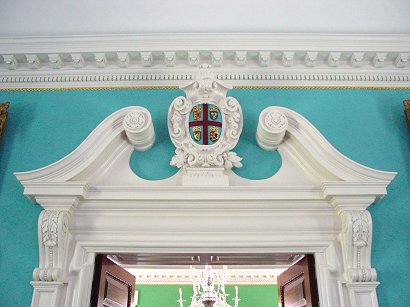
Williamsburg
Jamestown, the first permanent English settlement in the new world, was also the first capital of Virginia. In 1698, however, the capital was moved to Middle Plantation further inland on the James-York Peninsula. The town was named for King William, who had recently usurped the throne of James II in the Glorious Revolution of 1688. The town's College of William and Mary was also named after the new King William and his queen, Mary, the sister of the deposed king.
Capitol Building



Court


House of Burgesses
Virginia has the oldest continuously meeting legislature in New World, so it is fitting that the reconstructed capitol building is such a prominent part of Colonial Williamsburg. On one side of the lower floor is the court area, used only in cases of serious crimes punishable by death. On the other side is where the House of Burgesses met. Tensions rose with the mother country, and the legislature was eventually shut down.
Raleigh Tavern


Apollo Room
Members of the House of Burgesses met instead at the Raleigh Tavern, specifically in the Apollo Room.


Magazine
Late one night the Governor confiscated weapons and powder from the magazine, causing great resentment in the colony. After Patrick Henry's "Give me liberty or give me death" speech, the governor gave monetary compensation to the colony for his acts. Resentment remained, however.
Governor's Palace



With increasing unrest, the Governor fled to a ship of the royal navy and waged war on the people of Virginia. After some small scale fights at Norfolk and Gwynn's Island, for example, royal power was expelled from Virginia. This chain of events was important in bringing the southern colonies into the Revolution. Fighting returned to the state later in the war, and the Governor's Palace was used as a hospital during the Yorktown campaign. A section of the garden, which is marked, was used as a cemetery.

The weapons inside the palace, displayed in European fashion, had been meant to impress visitors with the power of government. Instead, rebels used the weapons to fight the government.


Wren Building - College of William and Mary
The college of William and Mary was an important feature of the town and an asset to the state. During the Yorktown campaign it was used as a headquarters and a hospital. A fire caused by French soldiers damaged one of the buildings.

Wythe House - Washington's HQ
Never actually owned by George Wythe, this house was used as a headquarters by George Washington during the Yorktown campaign. As a former member of the legislature, Williamsburg would have been very familiar to the commander in chief. He choose the best house in town.


Peyton Randolph House
Rochambeau's headquarters were in the Peyton Randolph House. Randolph wasn't bothered by this because he had died in the fall of 1775, having never seen fully the fruits of his revolutionary labors. At the time of my visit, the house was occupied by some unusually sarcastic and bossy employees of Colonial Williamsburg. Perhaps they should have found a line of work that didn't involve interacting with the public.

Town Declines
Being on a peninsula during a war with the greatest naval power in the world was not the best location for a capital city. The capital was moved to Richmond, and Williamsburg declined economically, no doubt to the great detriment of many people, including makers of fancy furniture for example. By the early 20th century, the town was a poor curiosity visited by a few hardcore historical tourists. This changed starting in the 1930s, when Rockefeller money secretly purchased much of the town, and a massive reconstruction process was begun.
Back to Revolutionary War Virtual Battlefield Tours